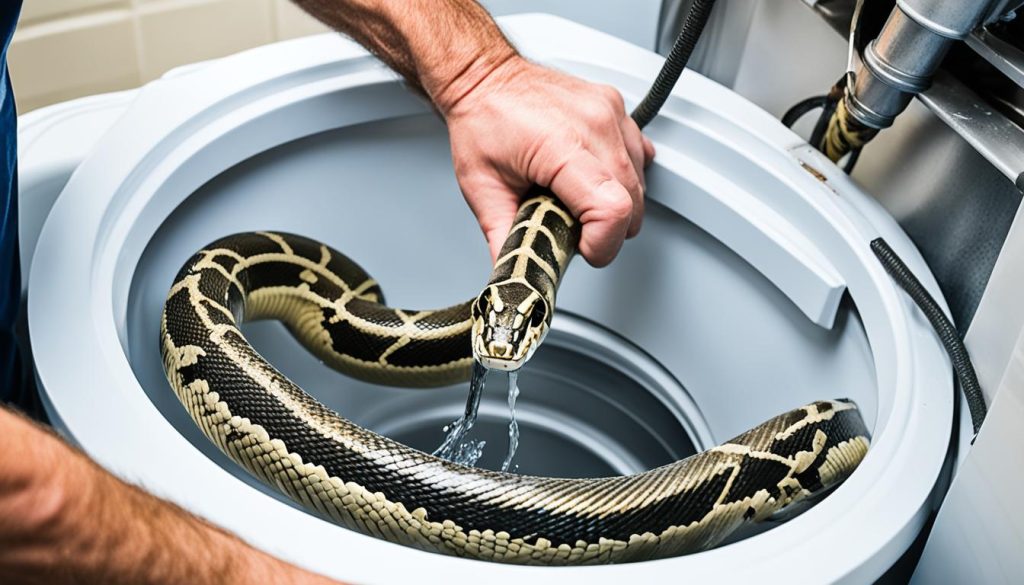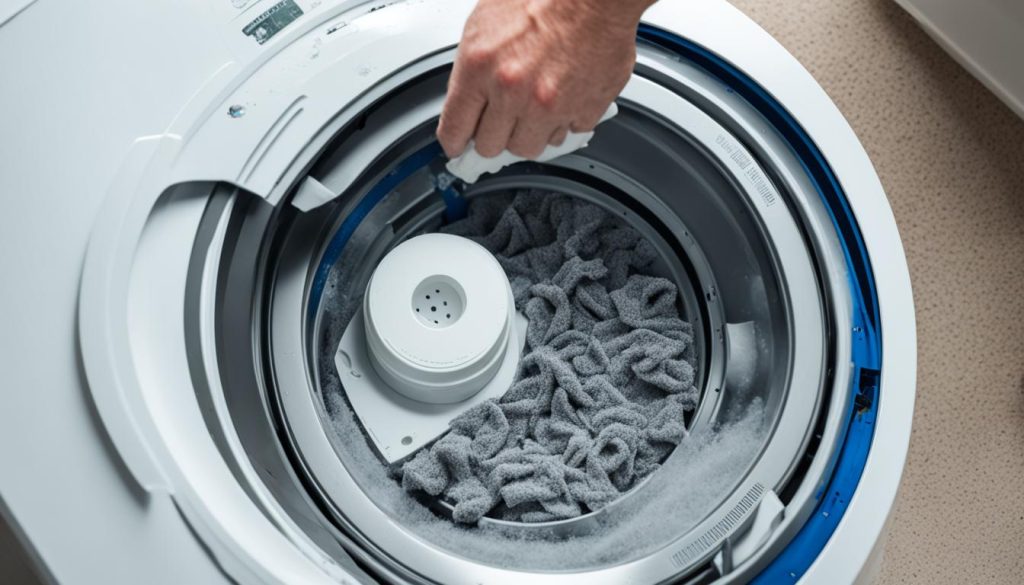Easy Cleaning Washing Machine Drain Guide
Keeping your washing machine drain clean and free of blockages is essential for maintaining the smooth operation of your machine. Over time, soap scum, debris, and dirt can accumulate in the drain, causing it to become clogged and hinder proper drainage. This can result in longer washing cycles, poor cleaning performance, and potential damage to your machine.
To prevent these issues and ensure your laundry day runs smoothly, it’s important to know how to clean your washing machine drain effectively. In this guide, I’ll walk you through simple steps to maintain a clean and clear washing machine drain.
Key Takeaways:
- Regularly cleaning your washing machine drain prevents clogs and drainage issues.
- Shut off the water and disconnect the drain hose to inspect and remove any blockages.
- Use hot water and vinegar or a commercial drain cleaner to remove minor clogs and soap buildup.
- A drain snake can be used to clear blockages in the drain pipe.
- Clean the filter to prevent debris from clogging the drain.
- Perform regular maintenance to keep your washing machine drain clean and optimize performance.
Shut Off the Water and Disconnect the Drain Hose
When it comes to cleaning a clogged washing machine drain, the first step is to shut off the water supply lines and disconnect the drain hose from the back of the machine. This simple action allows you to inspect the hose for any blockages that may be causing drainage issues.
Inspecting and cleaning the drain hose is essential for maintaining a properly functioning washing machine. Over time, debris such as lint, soap residue, and small objects can accumulate in the hose, leading to clogs and reducing the efficiency of your machine.
To effectively clean the drain hose, you can use a drain auger or a commercial drain cleaner. These tools are designed to remove stubborn blockages and restore the proper flow of water through the hose.
Be sure to remove the drain hose from the machine before attempting to clear any blockages. This prevents the risk of pushing the blockage further into the machine and causing damage. Take your time and carefully navigate the drain hose, ensuring thorough cleaning and restoration of proper flow.
Cleaning the Drain with Hot Water and Vinegar
If you have a minor clog in your washing machine drain, there are a few DIY methods you can try to clear it out. One effective method is using hot water and vinegar, which can help break down soap buildup and scum. Here are the steps to follow:
- Start by boiling a large pot of water.
- While the water is boiling, mix equal parts white vinegar and water in a separate container.
- Once the water has reached a rolling boil, carefully pour it down the drain.
- Next, pour the vinegar and water mixture down the drain.
- Allow the mixture to sit in the drain for about 15 minutes. This will give it time to break down any residual soap or scum.
- After 15 minutes, flush the drain with hot water again to rinse away any loosened debris.
This DIY method is a cost-effective and environmentally friendly way to clean your washing machine drain. The acidity of the vinegar helps to dissolve and remove soap buildup, while the hot water flushes away any loosened debris.
For more stubborn clogs or if you prefer not to use vinegar, you can also try using a commercial drain cleaner. Be sure to follow the manufacturer’s instructions and take proper safety precautions when using these products.
In the next section, we will explore another effective method for cleaning a clogged washing machine drain using a drain snake.
| Pros | Cons |
|---|---|
| Cost-effective method using household items | May not be effective for severe or stubborn clogs |
| Environmentally friendly alternative to harsh chemicals | Requires boiling a large pot of water |
| Easy and safe method for regular maintenance | May need to repeat the process multiple times for best results |
Using a Drain Snake to Clear Blockages
When it comes to cleaning a clogged washing machine drain, one effective method is using a drain snake. This handy tool can help you remove any blockages and keep your drain flowing smoothly. Here’s how to do it:
- Start by removing the drain pipe from the machine. This will give you access to the drain where the clog is located.
- Insert the drain snake into the pipe, making sure it goes in smoothly.
- Slowly push the drain snake down the pipe while rotating the handle. This motion helps collect any sediment or dirt that may be causing the clog.
- Once you reach the clog, gently pull the drain snake out of the pipe. Be careful not to damage the pipe or push the clog further into the drain.
- Remove any debris or blockages you find on the drain snake.
- Reattach the drain pipe to the washing machine.
- To test if the clog has been cleared, run a wash cycle and check if the water drains properly.
Using a drain snake is a quick and effective way to clean a clogged washing machine drain. By removing any blockages, you can prevent future clogs and maintain the optimal performance of your washing machine.
Cleaning the Filter to Prevent Clogs
One important aspect of washing machine drain maintenance is cleaning the filter regularly to prevent clogs. Over time, debris can accumulate in the filter, obstructing the flow of water and causing drainage issues. By following a few simple steps, you can keep your washing machine drain clear and functioning smoothly.
To begin, locate the filter on your washing machine. Depending on the model, the filter may be located on the front or side of the machine. Refer to your machine’s manual for specific instructions on how to access the filter.
Once you’ve located the filter, remove it carefully. In some cases, you may need to use a screwdriver or other tool to loosen the filter before removing it. Take care not to force or damage the filter during this process.
After removing the filter, rinse it off with water. Pay close attention to the mesh of the filter, ensuring that any debris stuck in it is removed. A gentle stream of water should be sufficient to clean the filter thoroughly.
Once the filter is clean, reinstall it in its original position. Ensure that it is securely fastened before proceeding.
To verify that the drain is clear, run a test cycle on your washing machine. Observe the water flow and check for any signs of clogs or slow drainage.
Regularly cleaning the filter is a key practice for preventing washing machine drain clogs. By taking this simple step, you can maintain the efficiency and longevity of your machine.
Regular Maintenance for a Clean Washing Machine Drain
In order to keep your washing machine drain clean and prevent clogs, it is crucial to perform regular maintenance. This includes periodically cleaning the drain using the methods mentioned above, as well as checking for any leaks or signs of blockages.
By taking the time to clean your washing machine drain and inspect it for any issues, you can ensure optimal performance and extend the lifespan of your machine.
Make it a habit to clean your washing machine drain at least once every few months, or more frequently if you notice any drainage problems or unpleasant odors. This simple maintenance task can save you from the inconvenience and expense of dealing with a clogged drain.
- Investing Wisely: How Windows & Doors in Boost Property Value and Financial Health - April 24, 2025
- The Financial Impact of Personal Injuries: Why Legal Help Matters for Business Owners - April 16, 2025
- The Hidden Financial Costs of Domestic Assault: What Business Owners Need to Know - April 16, 2025














